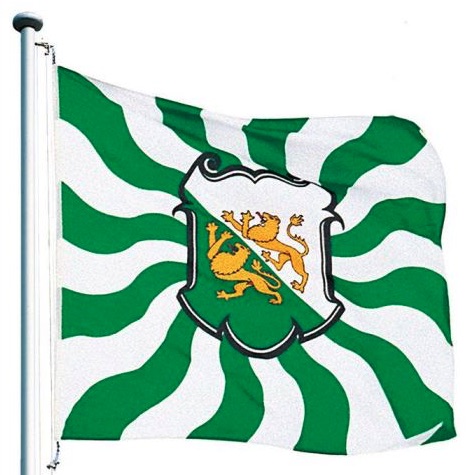Thurgau canton (Switzerland) (original) (raw)
The field is divided diagonally green in the hoist and white in the fly. Each part is charged with a golden lion walking upwards toward the staff. The golden lion on the white field constitutes a major violation of heraldic rules by mixing metals and creating a visibility problem.
T.F. Mills, 2 November 1997
With the restoration of the Swiss Confederationin 1803, and the creation of Thurgau as one of its six new cantons, the local "revolutionary" government tinkered with the old arms, omitting the bend and changing the red field to green and white (Cf. Vaud andSt. Gallen). They were not schooled in heraldry, and did not realise that they had violated a major rule by putting metal on metal (golden lion on white field). The lion is normally outlined in black which somewhat reduces the visibility problem. Attempts to correct this error have not succeeded. A proposal in 1938 would have made the whole field green, divided diagonally by a white "bendlet" (half the width of a bend).
Flag of 7th Shooters Battalion (ca. 1900, 107x109 cm), withcravat in cantonal colours. On the reverse side as usual the name of the Canton. Location: Historical Museum Thurgau, Frauenfeld (source).
Historical Thurgau Flags
Based on Todd's excellent texts, here's three historic Thurgau flags:
[![[The original Kyburg Counts arms]](http://www.crwflags.com/fotw/images/c/ch-tg094.gif) ](../images/c/ch-tg094.gif)image by António Martins
](../images/c/ch-tg094.gif)image by António Martins
The original Kyburg Counts arms, granted to Thurgau in 1094: sable, a bend between two lions passant bendwise, all or.
António Martins, 20 December 1997
[![[Flag of Thurgau 1264]](http://www.crwflags.com/fotw/images/c/ch-tg264.gif) ](../images/c/ch-tg264.gif) image by António Martins
](../images/c/ch-tg264.gif) image by António Martins
In 1264, Rudolf of Habsburg exchanged black with red.
António Martins, 20 December 1997
[![[Proposal flag of Thurgau 1938]](http://www.crwflags.com/fotw/images/c/ch-tg938.gif) ](../images/c/ch-tg938.gif)image by António Martins
](../images/c/ch-tg938.gif)image by António Martins
The correction proposal, refused in a 1938 referendum.
António Martins, 20 December 1997
Colour Flag
[![[Colour Flag TG]](http://www.crwflags.com/fotw/images/c/ch-tg_56.gif) ](../images/c/ch-tg%5F56.gif) image by Ole Andersen
](../images/c/ch-tg%5F56.gif) image by Ole Andersen
Simple rectangular cantonal flag, as shown in Kannik (1956) [So-called colour flag (Farbenfahne in German)].
Ole Andersen, 4 August 2002
See also: STATE COLOURS in Dictionary of Vexillology
| Flaggen, Knatterfahnen and Livery Colours | ||
|---|---|---|
[![[Knatterfahnen]](http://www.crwflags.com/fotw/images/c/ch-tg_f.gif) ](../images/c/ch-tg%5Ff.gif) ](../images/c/ch-tg%5Ff.gif) |
[![[Knatterfahnen]](http://www.crwflags.com/fotw/images/c/ch-tg_kf.gif) ](../images/c/ch-tg%5Fkf.gif) ](../images/c/ch-tg%5Fkf.gif) |
[![[livery colours]](http://www.crwflags.com/fotw/images/c/ch-tg_ff.gif) ](../images/c/ch-tg%5Fff.gif) ](../images/c/ch-tg%5Fff.gif) |
images by Pascal Gross
Flaggen are vertically hoisted from a crossbar in the manner of gonfanon, in ratio of about 2:9, with a swallowtail that indents about 2 units. The chief, or hoist (square part) usually incorporates the design from the coat of arms – not from the flag. The fly part is always divided lengthwise, usually in a bicolour, triband or tricolour pattern (except Schwyz which is monocolour, and Glarus which has four stripes of unequal width). The colours chosen for the fly end are usually the main colours of the coat of arms, but the choice is not always straight forward.
Knatterfahnen are similar to Flaggen, but hoisted from the long side and have no swallow tail. They normally show the national, cantonal or communal flag in their chiefs.
Željko Heimer, 16 July 2000
See also: HANGING FLAG, VERTICALLY HOISTED FLAG,LIVERY COLOURS in Dictionary of Vexillology
Early 20th Century Flag Design


 images located by Martin Karner
images located by Martin Karner
(source) (reverse | source) (source)
At the beginning of the 20th century, flamed flags were still in use, with the white cross replaced by a (baroque) shield in the centre of the flag. These decorative flags had been used until WWII and then somewhat forgotten in preference of the current cantonal flags. [Today they are being produced again, see image on the right.]
Pascal Gross, 30 June 2002
See also:
- National flag and other cantonal flags with "Early 20th century flag design"
- Modern flamed flags
- FLAMMES in Dictionary of Vexillology
Logo

(source)
Cockade
 image located by Martin Karner
image located by Martin Karner
(source)
Cockade for the cantonal troops' headgear (regulation from 1898, size: ca. 35 mm, reverse side).
Martin Karner, 14 March 2025
See also: Cockades (Swiss Army)